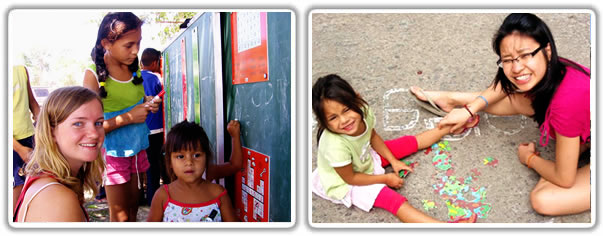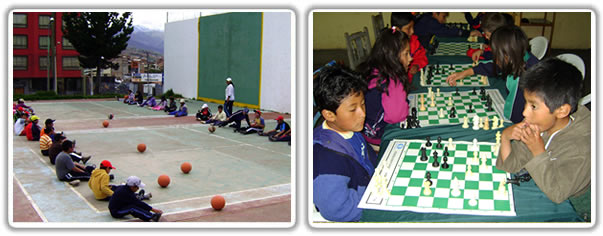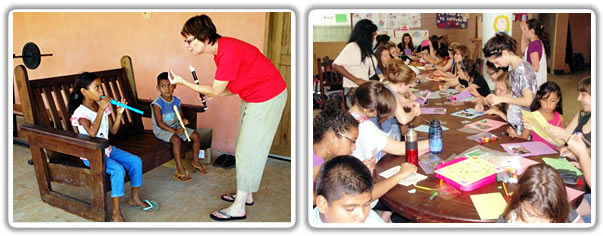Examples of volunteer activities with children!
Author: admin
Views
12.958
8 ago
Every volunteer has different talents and comes from a different cultural and professional background. Before starting your volunteer work in South America it is good to know what your strengths (and weaknesses) are. Talking to the project leaders about the possible activities you can do can be helpful, but often it is expected and appreciated that you come up with your own ideas and take initiative.
For this it’s important to take into consideration the age group of the kids, whether the volunteer project is set-up for girls or boys only and their social situation. For example, if you choose to work at an orphanage, you can encounter children that have problems with trusting others, and sometimes don’t want to talk or just walk away. At a social rehabilitation home, most children have problems with their families and at an afterschool project it’s difficult to coordinate group activities due to many different schedules.

Still it is possible that they do not like your prepared activity. Therefore it’s important to always have a plan B and know how to improvise a little. There are literally hundreds of activities you can do with children, and here we share some of the more popular ones:
Creative Activities:
Make figures or stamps from all kinds of household materials: dough, pasta, cardboard, matchboxes or even bottle lids.
Other favorites are masks, clothes, necklaces and bracelets with beads, accessory boxes for jewelry or perhaps a piggybank.
Mood-boards or collages based on dreams, birthday wishes, hearts with a message.
Dress-up (on an ordinary day or for special occasions, like x-mas), puppet theatre, pantomimes or putting on make-up.
Teach them to draw or paint simple illustrations, like facial expressions or landscapes. Or use chalk to decorate the streets!
Physical Activities:
Go to the play-garden and all have a go at the slide, tunnel and other fun attractions.
Gymnastics, football, volleyball or even martial arts and organize a competition.
Play or make an instrument; teach a famous song and practice its choreography (or invent one together).
Games while blindfolded: hide-and-seek, ‘Gallinita Ciega’ (the game of who is who in a closed circle) and trying to bite candy off a string without seeing it.
Introduce new games from your home country. Sure you remember some from your own childhood!

Concentration Activities:
Playing table games such as memory, jenga, jigsaw puzzles or bingo.
Plan a competition with origami, color-in drawings, Lego or how to fold airplanes. Small rewards such as hairpins or football cards turn out to be great motivators!
Teach them new card games or magic tricks.
The ever popular game of twister. Easy to prepare and guaranteed laughs!
Educational Activities:
Teach a language! Best to start with simple phrases in a structured way, e.g. different expressions, flavors, numbers, countries, animals and greetings. Picture cards can be very useful.
Helping them with their homework or reading a story with a message (of course, you need at least an intermediate level of Spanish for these ones).
Take the class out to a museum for children, the zoo or organize a treasure hunt in the park.
Teaching them about hygiene and rules. This can also include assisting the children taking a bath, brushing their teeth or simply cleaning up or doing the dishes.

Special Activities:
Plan a photo shoot and bring the prints to make a photo album together.
Take the older ones to the movies. A great bonding ritual.
Cook a special meal for them and try to avoid the usual rice and pollo. A healthy fruit salad, pancakes or a chocolate cake is all you need for a fun fiesta!
However, don’t be surprised that the children sometimes just prefer to sit and talk instead of doing other activities. Most go to school already and just want to enjoy their free time afterschool. Generally they are extremely interested in your ‘story’, country and language. Therefore, they are also very patient and helpful with your efforts to speak Spanish.
Whatever activity or way you spend time together, one thing is certain; you will make their world richer and your own as well!
Feel free to contact our volunteer coordinator for any questions, and for tips for working with children please read our previous articles here (part I) and here (part II).





5 Responses for "Examples of volunteer activities with children!"
Thanks for this informative blog! I have had a number of wonderful volunteering experiences with kids, which have been wonderful! However sometimes it is a little tricky to keep up the creativity and make more fun activities!
This is just the information that I was looking for! Thanks for sharing. Now I will be well prepared for my volunteering project that I booked in South Africa this coming spring!
Information found, problem solved, thanks!
I love what you guys are up too. This sort of clever work and reporting!
Keep up the wonderful works guys I’ve incorporated you guys to my personal blogroll.
Thanks everyone for the comments! We are so happy to be able to provide useful and fun information for you! If you are interested in volunteering in latin America just take a look here http://www.volunteerworklatinamerica.org/ of email us on info@volunteerworklatinamerica.org
Leave a reply